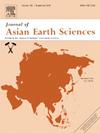Fluoride enrichment in geothermal waters based on H, O, Sr, and Li isotopes of the Taiyuan Basin, North China
IF 2.7
3区 地球科学
Q2 GEOSCIENCES, MULTIDISCIPLINARY
引用次数: 0
Abstract
Hydrochemical characteristics and fluid evolution are crucial for understanding geothermal water origins, assessing water quality, and evaluating regional seismic activity. This study investigates the hydrogeochemical processes responsible for elevated fluoride concentrations in the geothermal waters of the Taiyuan Basin. The investigation employed a combined approach, utilising water chemistry and isotopic data (δD, δ18O, 87Sr/86Sr, and δ7Li) from three distinct water sample types. These analyses elucidate the sources and mechanisms controlling fluoride enrichment in geothermal systems. The fluoride concentrations in these waters, ranging from 6.19 mg/L to 21.08 mg/L, were primarily influenced by water–rock interactions, mixing processes, and cation exchange. The isotopic data (δ18O and δD) indicate a meteoric origin for the geothermal waters and substantial interaction with carbonate and silicate minerals at reservoir temperatures between 110 °C and 140 °C. Elevated 87Sr/86Sr ratios (up to 0.716827) and δ7Li values (ranging from 8.2 ‰ to 20.4 ‰) further highlight extensive water–rock interactions, particularly with carbonate, evaporite, and clastic rocks. These processes facilitate the release of fluorides and other ions, thereby contributing to the increased salinity of geothermal fluids. Cation exchange, particularly between Na+ and Ca2+, further promoted fluoride retention in the solution, while evaporite dissolution contributed to the observed high salinity. The mixing between deep geothermal waters and shallower groundwater also influences geochemical variability. However, fluoride enrichment primarily occurs within the deeper geothermal reservoirs. This study highlights the complex interactions between hydrogeological, geochemical, and isotopic characteristics in controlling the fluoride concentrations within the Taiyuan Basin.

求助全文
约1分钟内获得全文
求助全文
来源期刊

Journal of Asian Earth Sciences
地学-地球科学综合
CiteScore
5.90
自引率
10.00%
发文量
324
审稿时长
71 days
期刊介绍:
Journal of Asian Earth Sciences has an open access mirror journal Journal of Asian Earth Sciences: X, sharing the same aims and scope, editorial team, submission system and rigorous peer review.
The Journal of Asian Earth Sciences is an international interdisciplinary journal devoted to all aspects of research related to the solid Earth Sciences of Asia. The Journal publishes high quality, peer-reviewed scientific papers on the regional geology, tectonics, geochemistry and geophysics of Asia. It will be devoted primarily to research papers but short communications relating to new developments of broad interest, reviews and book reviews will also be included. Papers must have international appeal and should present work of more than local significance.
The scope includes deep processes of the Asian continent and its adjacent oceans; seismology and earthquakes; orogeny, magmatism, metamorphism and volcanism; growth, deformation and destruction of the Asian crust; crust-mantle interaction; evolution of life (early life, biostratigraphy, biogeography and mass-extinction); fluids, fluxes and reservoirs of mineral and energy resources; surface processes (weathering, erosion, transport and deposition of sediments) and resulting geomorphology; and the response of the Earth to global climate change as viewed within the Asian continent and surrounding oceans.
 求助内容:
求助内容: 应助结果提醒方式:
应助结果提醒方式:


